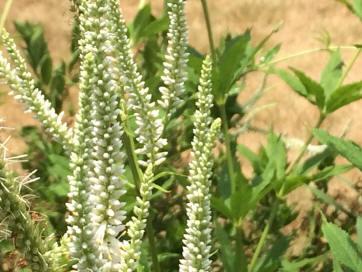Pam Haze
Adams County Master Gardener
 (7/5) If you want pollinators in your garden, and you should, plant Culver’s root Veronicastrum virginicum. It attracts a variety of beneficial insects including bees and butterflies. In addition to being a great source of nutrition for native pollinators, Culver’s root is a stately, bold plant that will add height and drama to your plantings. It is also durable, adaptable, and easily grown and, an added bonus, the foliage is unpalatable to deer and other wildlife.
(7/5) If you want pollinators in your garden, and you should, plant Culver’s root Veronicastrum virginicum. It attracts a variety of beneficial insects including bees and butterflies. In addition to being a great source of nutrition for native pollinators, Culver’s root is a stately, bold plant that will add height and drama to your plantings. It is also durable, adaptable, and easily grown and, an added bonus, the foliage is unpalatable to deer and other wildlife.
Culver’s root is a native herbaceous perennial. It grows about five feet tall (some cultivars are smaller in stature) with dark green willowy foliage and tall wand-like flower spikes that resemble candelabra. It is a great addition in the back of a perennial border, in a mixed border, or as an accent plant in naturalistic, cottage gardens or wildflower gardens.
The plant grows in a clump (up to about four feet wide) from single stems that rise up from the ground and branch at the base of the flower spike. Slender finely toothed leaves are arranged in whorls around smooth, round stems. Tubular-shaped four-petaled flowers are densely clustered around each flower spike. Flowers mature and open from the bottom to the top of the spike and last for about a month.
Culver’s root is native to the eastern United States. It can be found in the wild in moist prairies, woodlands, thickets, savannas, and swampy meadows along rivers and ditches. It is well suited to our local climate and growing conditions, requires little care, and is disease resistant. It grows in full sun or light shade. If it gets too much shade the tall stems may lean or flop, but they can be supported with stakes and string. The plant will prosper in average, medium wet, well-drained soils, but it will also tolerate less than optimum soils and moisture levels.
Plants grow slowly in the first year but make up for it in subsequent years. A central taproot and rhizomes enable vegetative reproduction, but the plant is not overly aggressive. It is most easily propagated by division in the late fall or early spring. The small seeds can be directly sown into the soil or stratified to grow indoors.
In Gettysburg, flowering begins in June and lasts through most of July. You can cut back the stems after flowering to promote growth of new foliage and reblooming. Flower spikes can be cut for arrangements, lasting about a week in water.
Culver’s root plants can be purchased from nurseries that carry native plants, including the straight species with white flowers as well as a number of cultivars bred for selected characteristics including Veronicastrum virginicum ‘Diana’ with pure white flowers and a compact growing habit; ‘Fascination’ with light violet-blue flowers; and ‘Lavender Towers’ with purple flower spikes.
The plant has long been valued for its medicinal qualities by Native Americans and pioneers. The Cherokee used it as a tea for backaches, fever, typhus, and other ailments; the Seneca used it as a laxative; and the Menomini used it to purge the body of evil spirits.
The name Culver’s root is believed to have originated from Dr. Coulvert who popularized its use as a laxative during the late 17th and early 18th centuries. The scientific name Veronicastrum is a combination of Veronica and the suffix astrum, which means false, describing the plant’s resemblance to closely related Veronica plants. It was first discovered and collected in Virginia, thus it’s species name virginicum.
Growing Culver’s root in your garden will contribute to its conservation and protection. It is currently of conservation concern in 13 states (not Pennsylvania) and two Canadian provinces. It is threatened in Massachusetts and New York and endangered in Vermont. The designation confers protection of the plant and its habitat, which is threatened primarily by development, invasion and competition by exotic plants, and herbicides.
Read other articles by Pam Haze